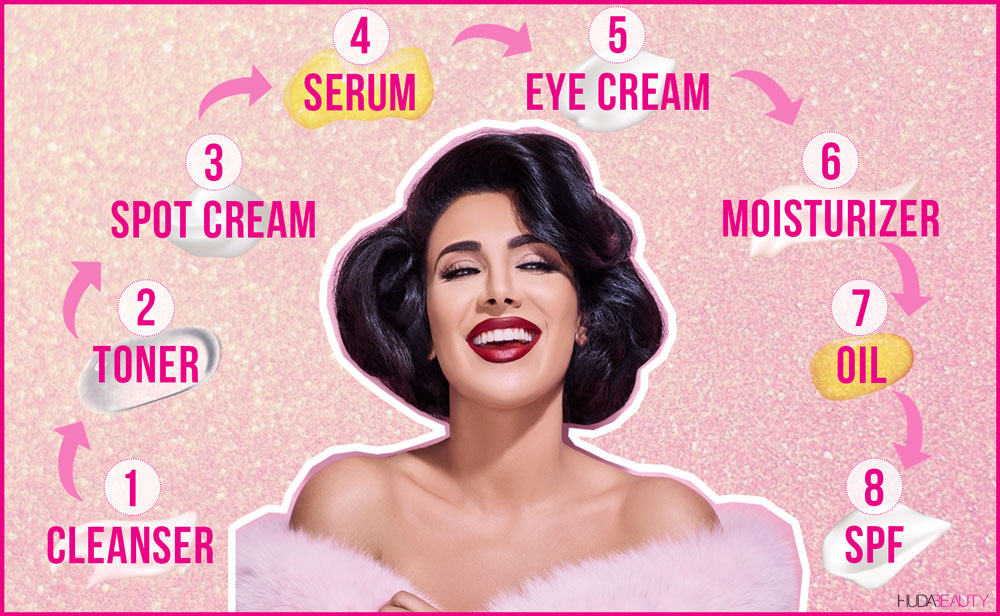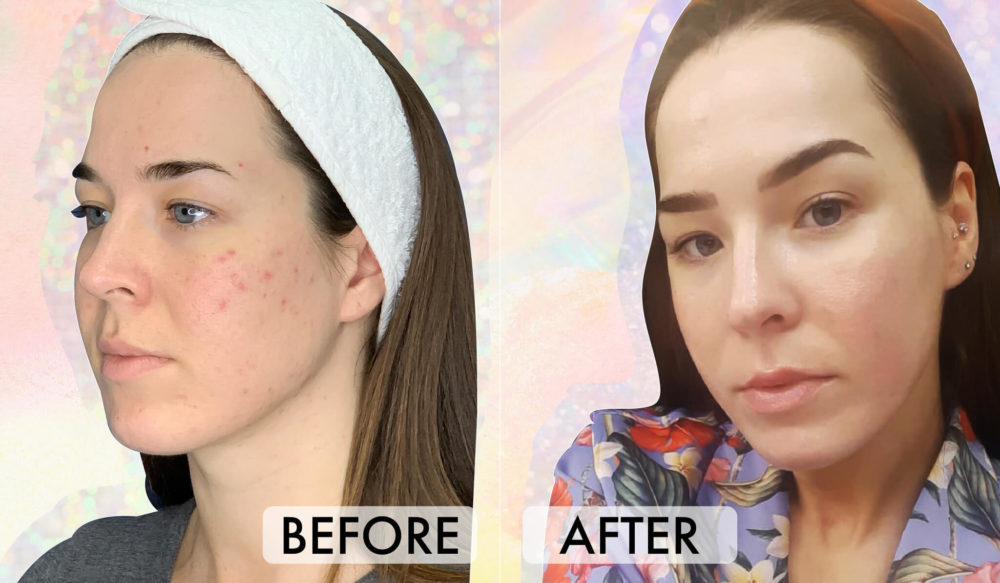Are You Guilty Of The Most Unspoken About Skincare Rule?
 via Giphy
via Giphy
In the past five years, our skincare regimen has gone from three simple steps and a splash of water to a 14-step routine that would put a K-beauty ambassador to shame. But the harsh reality is, as accomplished as we feel lathering the 7th miracle ointment into our skin, it could be doing more harm than good (and costing us a hell of a lot more).
When it comes to skincare, the “less is more” approach is sometimes the best! So, while we love our vast beauty collection, there’s a rule that isn’t often mentioned, but really is very important: don’t overwhelm your skin with too many products. But don’t worry, we’re not suggesting that you ditch every cream in your cupboard, just that you simplify and tailor your beauty regimen for your skin’s unique needs. Here are the five essential steps of customizing your skincare regimen, and making sure you’re not applying too much product and consequently overwhelming your skin…
The Signs You’re Doing Too Much:
Before we get into the routine, you need to be able to recognize the signs that you’re overwhelming your skin with too many products. Over-exfoliation is a common skincare mistake, and if your skin looks shiny, overly oily or extra dry or sensitive to the touch, you could be over-exfoliating. Sensitive, red or itchy skin or constant breakouts could also be a sign that you need to consider simplifying your routine.
Posts You'll Love:
Step 1: Get to know your skin type
Possibly the most important step of tailoring your skincare regimen is getting to know your skin type. The common skincare categories are sensitive, dry, normal, oily, acne-prone, and maturing skin concerns, but of course, you’ll often be more than one of these. You could be both oily and acne-prone, mature and dry, or even sensitive and acne-prone. You may also be dry during the winter and oily during summer, so bear this in mind.
Knowing your skin type means you can look for formulas that are tailored to you; for example a moisturizer for dry skin will most likely be a thick cream as that’s the best type of moisturizer for dry skin, whereas oily skin requires a lighter, water-based formula, like a gel, so that it doesn’t clog pores. Similarly, if you have sensitive skin, products for your skin type will contain gentle ingredients and will likely be fragrance-free, whereas if you have mature skin, your products will contain strong, active ingredients to improve the appearance of age spots, fine lines, and wrinkles. If you’re unclear of what skin type you have, check out our skin type break down.
Step 2: Know how much to apply
Sometimes it feels great to slap on a load of moisturizer, but that doesn’t necessarily mean better hydration, as the excess product that’s not absorbed will just sit on the surface of your skin. Check out our size guide below – you’ll definitely be surprised at how much you really need.

Step 3: Check your active ingredients
Chances are (especially if you’re a beauty junkie like us) if you’re using a lot of strong products, like an AHA exfoliator and retinol, you’re overloading on active ingredients. For those of you who aren’t familiar with the term active ingredients, they’re the most potent, impactful ingredients, which often only make up 2% of the overall product (you don’t need a lot because they’re so strong). Some of the most common active ingredients include AHAs (glycolic and lactic acid), BHAs (salicylic acid), vitamin C, and retinol. However, as they’re quite harsh ingredients, you need to be really careful how much you use them. For example, if your cleanser, moisturizer, and exfoliator all contain AHAs and you use them every day, you could be over-exfoliating your skin and damaging your skin’s barrier, which could lead to more breakouts. When it comes to how much of an active ingredient you should apply to your skin, stick to this general rule: the stronger the product, the less frequently you want to use it, and the more careful you need to be with using it with other potent formulas.
Posts You'll Love:
Another common trap you may be falling into that could be overwhelming your skin is not understanding the purpose of the active ingredient and then using another active ingredient that does the same thing. For example, lactic acid is amazingly hydrating acid, but it’s also an exfoliator – if you’re using this on the same day that you’re using an AHA toner or a salicylic acid serum, you could be over-exfoliating. To help you avoid making this mistake, here’s a quick breakdown of the most common active ingredients.
AHAs (glycolic, lactic acid, citric acid): Although there’s more than one type of AHA and they all have slightly different capabilities, they all exfoliate the top layer of the skin to reveal, smoother more hydrated skin. If you have mature skin, a product containing AHAs is a must – but of course, you don’t need to use it every day if you’re using a retinol.
BHAs (salicylic acid): BHAs break down the ‘glue’ that holds dirt and debris in your pores together and will loosen the barrier of your pores, helping you shed the dead skin that sits on the surface. BHAs are also oil-soluble, which means it has a smaller molecular structure so it can reach deeper into the pores and is an anti-inflammatory and antibacterial.
Vitamin C: Vitamin C is THE beauty vitamin! It can be used on all skin types and will help soothe and brighten skin while keeping signs of aging in check and correcting uneven skin tone. It’s perfect for the morning as it’s full of antioxidants that’ll fight free radicals that your skin will come into contact with during the day.
Retinol: Retinol is a form of vitamin A; when you apply it to your skin, it converts to retinoic acid, which boosts skin cell renewal. Retinol thickens the deeper layer of your skin, smoothes out wrinkles by increasing collagen production, and helps balance oil production, which helps tighten the appearance of pores and improve acne.
 via Giphy
via Giphy
Step 4: Know when to apply
Knowing how to layer your skincare is SO important. If you layer incorrectly, you run the risk of your products becoming completely ineffective as they won’t absorb into the skin. Firstly, make sure your skin is completely clean before you apply any hydrating lotions or oil by double cleansing. Then, the general rule is to apply the most lightweight formulas first, so they can be easily absorbed without the barrier of heavier creams. After each layer, give your skin time to absorb the product (at least a few minutes), this will also mean when you’re layering your products they won’t pill – those tiny little balls you get when you’ve used too much product. You can also use a gentle patting motion to push the lotion into your skin – one of our fave K-beauty hacks.

Step 5: Know when to switch up your regimen
Even when you thought you couldn’t tweak your regimen anymore, we’re here to tell you… You can! Your morning and evening regimen don’t need to be the same. Your evening routine might include richer, more hydrating products because your skin loses more moisture during the night. You’ll also need to wipe away all of the dirt and pollution of the day, which means double cleansing and toning is essential. Your morning routine should be simpler. For example, if you have oily skin, you may want to consider putting less on your skin – you may only need to tone and use a serum, and of course, SPF, however in the winter, you may want to include a gel moisturizer to ensure your skin is protected and hydrated in the cooler climate. It’s all about getting to know your skin, and seeing what works, so test a routine for a few days or a week, and if it’s not working try something else.
Finally, remember that environmental factors can have a significant impact on your skin as well. For example, your skin is more likely to be oily in the summer, yet drier during the winter, so during the winter you may need to use heavier creams with rich ingredients like shea butter. For more deets on seasonal skincare changes, check out our winter skincare guide.
Let us know if there are any other skin-related-concerns that you’d like us to write about in the comments below.























Leave a comment